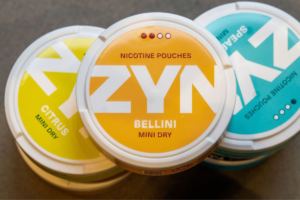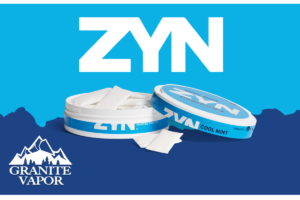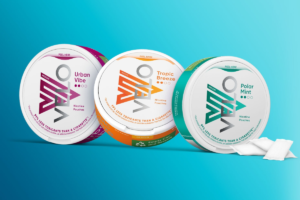There is a long history behind Swedish Snus which makes it distinct from other oral nicotine delivery systems. It is said to be the best and most varied tobacco product in the market. Making Snus requires using a unique pasteurization process which produces it with distinct characteristics contrary to how other smokeless tobacco products are fermented. In addition, there are now nicotine pouches accompanying traditional Snus that do not contain any tobacco but still provide similar experiences with potential differences in health consequences. This paper seeks to expound on both Swedish Snus and nicotine pouches as far as their production techniques, uses, regulatory environment and their place within the wider scope of tobacco harm reduction are concerned. For accurate and detailed knowledge about snus and nicotine pouches, experts as well as enthusiasts can depend on this piece.
What is Snus and How Does it Differ from Other Tobacco Products?

images source:https://en.wikipedia.org/
Swedish Snus, its Origins and History
Snus originated from Europe in the early 18th century as a type of dry snuff which was first inhaled. However, the tobacco product underwent a wet transformation that took place in Sweden whereby it was placed under the lip to give us what we know today as Snus. Some of the things that set Swedish Snus apart from other types of tobacco are:
- Pasteurization: Instead of fermenting like most tobacco products do, Snus is usually steam-pasteurized. The significance of this process cannot be underestimated since it helps to prevent potential carcinogens known as tobacco-specific nitrosamines (TSNAs) from forming.
- Placement and Usage: For them to be consumed, people put Snus under their upper lips and they don’t need spitting unlike other forms such as chewing tobacco enabling them to use it discreetly.
- Moisture Content: This also means that moisture levels are higher in Snus compared with dry snuff resulting in different feeling and possibly even an altered rate at which nicotine is absorbed by an individual.
- Salt and Flavorings: Besides providing taste distinctions for Snus, these additives help maintain its quality over time.
- Regulation and Standards: In Sweden, production of Snus is regulated by stringent guidelines such as those spelled out in the Swedish Food Act unlike other less-regulated smokeless tobaccos found abroad.
- Portioning: Snusers who prefer different levels of convenience and control over nicotine intake can either buy loose or portioned sachets.
This combination makes Swedish Snus unique both as an artifact steeped into culture but also as an interesting item within the context of harm reduction strategies.
Exploring the Various Types of Snus Products Available
In the market, snus comes in different varieties of products that cater to different consumer needs. Below are the main types:
- Original Portion: Typically moist, they are meant to release flavor and nicotine quickly when inserted in one’s mouth. The moisture content normally ranges between 30% and 50%, thus ensuring intense immediate experience.
- White Portion: These have lower levels of moisture – usually between 20% and 30% – making them release their flavors and nicotine slowly. They are best for those who want a less intense feel as they possess a mild nature.
- Strong and Extra Strong: Their high nicotine contents ensure maximal tobacco absorption rates ranging above 14 milligrams per gram.
- Mini Portion: When it comes to size, these pouches are smaller than the rest meaning that they contain minimal amounts of tobacco and nicotine for use by individuals looking to be modest about it.
- Nicotine-Free: These alternatives do not contain tobacco leaves or any amount of nicotine but imitate the taste and feeling of Snus through use of alternative fibers and flavors instead.
- Flavored Variants: There is a wide range of aromas including berry, mint, citrus or licorice which broaden available choices among consumers improving their sensory experiences.
It should be remembered that the level of nicotine concentration as well as portion size directly influences how fast an individual gets affected by and how long effects associated with such exposure last. Manufacturers meticulously calibrate these parameters to produce snus varieties that align with the distinctive usage patterns and preferences observed across consumer segments.
Comparing Snus and Traditional Chewing Tobacco
Both Snus and traditional chewing tobacco are smokeless forms of tobacco but how they are used, manufactured and their health impact is significantly different. Observe that traditional chewing tobacco can be in form of loose-leaf, plug or twist tobacco which users place in the mouth before active chewing to extract flavors as well as nicotine. This often leads to saliva being produced which the user has to spit out; consequently there is increased risk related with such diseases as mouth cancer and throat cancers. Unlike snuff sachets, Snus is a moist powder tobacco that has been pasteurized and it is consumed by placing it under the upper lip without requirement for spitting. Meanwhile, during the manufacturing process for snus, pasteurization brings down significantly the levels of TSNA (tobacco-specific nitrosamines), powerful carcinogens found in much higher amounts in traditional chewing tobaccos. As a result, there have been associations made between Snus use and reduced risks of oral cavity or throat cancers, as well as those affecting other parts of digestive system compared to smoking conventional chewable ones. People who want a smokeless product that may be less hazardous to health prefer discreetness associated with using snus without spitting it out together with its controlled way of delivering nicotine so Is an alternative favored by many people who prefer using smokeless snuff laden with lower chances/effects on one’s health?
Benefits of Using Snus as an Alternative to Smoking
Exploring the Snus’ Potential for Harm Reduction.
Research has found that snus may present harm reduction potential for individuals looking to alternatives to smoking cigarettes. The term “harm reduction” refers to strategies that seek to mitigate the health consequences associated with specific practices, like tobacco use. Here are some of the factors that make Snus a possible tool for harm reduction:
- Reduced Level of Destructive Constituents: In Snus, through pasteurization process, levels of tobacco-specific nitrosamines (TSNAs) have been reduced significantly than what is in other tobacco products. TSNAs are among primary carcinogenic components in tobacco and contribute to cancer risk.
- Nicotine Delivery without Combustion: Nicotine —the addictive substance for smokers—is delivered by Snus without smoke which goes together with combustion on cigarettes and it leads to the lung into toxins and several harmful substances released in them.
- An Alternative Route of Administration: Users place Snus under their lips, allowing nicotine absorption through mouth resulting from mucous membranes. This avoids damaging effects of smoke on respiratory system.
- Behavioral Similarity to Smoking: Smokers’ behavioral routines such as hand-to-mouth action can potentially be satisfied by using this product thereby becoming instrumental in helping people shift away from cigarette smoking.
- Epidemiological Evidence: Population studies conducted especially in Sweden where Snus has gained popularity have indicated decreased prevalence rates of smoking and lower incidences of smoking-related diseases which could be attributed to its employment as an alternative for cigarettes.
- Public Health Endorsement: Some public health organizations are beginning recognizing that using snuff rather than smoking is a relatively low risk alternative consistent with principles of harm reduction.
It is important to consider harm reduction as part of a comprehensive strategy towards public health aimed at decreasing morbidity and mortality related to tobacco use. However, snus use carries risks but should be evaluated within available scientific information regarding its contribution towards reducing hazards associated with smoking.
Snus and Cigarettes: How Do They Compare in Terms of Health Risks?
In terms of health risks, there is an obvious difference between snacks and cigarettes because they are consumed differently. This is a key distinction since snus does not burn therefore no inhalation of fire related toxins and carcinogens. According to studies, cigarette smoke contains over seven thousand chemicals out of which at least two hundred fifty have been known to be toxic such as hydrogen cyanide, carbon monoxide as well as ammonia. In contrast, Snus has a much lesser amount of cancer-causing compounds though it also has some chemicals.
Cancer risk shows a clear divergence between Snus and cigarettes. For instance, according to the International Agency for Research on Cancer (IARC), cigarette smoking is significantly associated with lung, mouth, esophagus, throat and many other cancers while no conclusive evidence links snus use with these diseases. That said; IARC states that findings are inadequate to suggest that this substance leads to any specific cancer like tobacco smoking where it can be said with certainty that it causes cancer.
Additionally, Snus appears less dangerous for the cardiovascular system than smoking does—it has lower cardiovascular risks compared to those associated with cigarette use. Tobacco smoking is one of the major causes of heart diseases due to how smoke affects the heart’s vascular system functions; however research reveals that snuff users might face slightly higher risks for myocardial infarction compared to non-users although still lower than smokers.
However Snus should not be seen without risks—nicotine is present in it. Nicotine is an addictive substance which tends to increase heart rate along with blood pressure thereby may lead towards nicotine dependency. Consequently, despite being less harmful than cigarettes by comparison health professionals commonly advise stopping all forms of tobacco use as the best way possible for reducing its consequent health hazards.
It is important that these findings emanate from peer reviewed scientific journals and keep on updating the assertions of risk from the latest available research for accuracy.
Tobacco’s Effects On Nicotine Addiction.
There is a high risk of nicotine addiction due to the high levels of nicotine content in smokeless tobacco products like Snus. An example is a study appearing in Nicotine & Tobacco Research (2020) which showed that users of smokeless tobacco products have similar patterns of nicotine dependence as those who use cigarettes. The practical implications are enormous, given that nicotine is one substance known for its addictive nature which can modify brain functioning and hence escalate tolerance levels and withdrawal symptoms when one attempts quitting. In this respect, the research found out that regular Snus users could feel cravings and experience withdrawal symptoms just as traditional cigarette smokers do when they stop using the product. Thus, though smokeless tobacco might limit the exposure to cigarette by-products from combustion, it does not reduce any risks associated with nicotine addiction and may compromise campaigns aimed at ending all forms of tobacco consumption.
Where can you purchase Swedish Snus and Nicotine Pouches online?
Exploring Authentic Online Retailers to Purchase Swedish Snus
While picking out reliable online retailers for buying Swedish snacks and nicotine bags, buyers should consider merchants that are clearly transparent on the sources of their products, ingredient lists as well as adherence to the set laws. An example of such a place is Bapro team which is an ecommerce group that deals with smokeless tobacco distribution. They ensure all their goods are bought from genuine manufacturers thus establishing their credibility and facilitating quality assurance among consumers.
One remarkable thing about Bapro team is its effort in educating customers extensively. This includes providing comprehensive information about each product such as flavor profiles, nicotine strength and usage instructions that cater to both beginners and experienced users. Moreover, they have incorporated tight security features into their platform to safeguard customer data considering the privacy nature of personal and financial details.
Moreover, when determining appropriate online vendors for purchasing snuffs, important data like consumer feedbacks, shipping durations or refunds terms must be thoroughly analyzed. User testimonies indicate high level of satisfaction associated with Bapro’s services besides competitive shipping practices together with a definite return policy meant to solve any dissatisfaction by customers whenever it arises. In summary these qualities make this company an authentic dealer in fine snuff market today.
How to Make Sure Your Snus Order Online is of High Quality
- Verify Authenticity of Retailers: To determine whether the online retailer is authorized to sell snacks and nicotine pouches, check their licenses and certifications.
- Consider Product Options: Choose retailers that have a wide range of products and brands so as to ensure that you have access to good quality items.
- Quality Guidelines Analysis: There should be explanations in regard to adherence to manufacturing processes, expiry date confirmation and quality control procedures for the retailer’s offered products on its website.
- Go Through Client Feedbacks: Evaluate what other customers say about different services they received from this seller through their testimonials or rating.
- Transparency in Ingredients Information: Such kind of information like complete product ingredient lists with details about nicotine content and flavor profiles must be available from known businesses before buying any product from them.
- Observance of Compliance with Regulations: Confirming that all requirements stipulated by law are adhered to by this business brand when selling tobacco products within your locality is important.
- Comprehend Shipping Procedures: For one who buys products online, analyze how these goods will be transported without interfering with them at any cost during the entire process using a given seller’s rules.
- Assessment of Return Policies: The policies that govern the return of commodities bought from various suppliers as well as protocols over returned properties within an establishment need careful consideration too.
- Examine Security Measures: Hence, you must make sure that this web-based seller has implemented some reliable security systems so as to safeguard your personal data and financial details appropriately.
- Think About Customer Service Provision: You would rather choose sellers who have robust customer care services such that any issues or questions can find quick responses.
Health Considerations and Risks Associated with Snus Use
Understanding the Association Between Snus Use and Health Risks
While snus is commonly viewed as a safer choice when compared to smoking because of its absence of combustion and hence no involvement in smoke inhalation, it is crucial that one understands its use carries with it inherent health risks. Comprehensive studies show that Snus contains nicotine, which is highly addictive and can lead to addiction. Also, research proves this substance’s connection with numerous types of cancers such as pancreatic or esophageal ones. However, this risk is significantly lower than in smoking cigarettes. Again, there are also epidemiological data suggesting possible associations with cardiovascular diseases like heart attack particularly among individuals having such history before the onset for their ailment. It is important for consumers to evaluate this risk and for regulatory bodies to enforce stringent labeling while deploying public education campaigns for disseminating this vital health information.
Do the Use of Smokeless Tobacco Have Any Long-Term Health Effects?
Determining these complex and multifactorial health dangers should be based on a through evaluation of clinical data from smokeless tobacco use such as Snus:
- Addictive properties: Nicotine is the chief addictive substance in smokeless tobacco inducing dependance and chronic use, making it difficult to quit.
- Cancer risks: Prolonged consumption of smokeless tobacco increases the chances of developing certain types of cancer particularly oral, esophageal, and pancreatic cancer; this is due to presence of tobacco specific nitrosamines which are carcinogenic.
- Dental health impact: Smokeless tobacco users can experience dental problems like gum recession, tooth decay, and mouth lesions that can lead to oral cancer.
- Cardiovascular disease: Current research suggests that smokeless tobacco may increase the chance of heart disease and stroke perhaps due to nicotine’s cardiovascular effects.
- Reproductive health: Stillbirths or preterm delivery during pregnancy are some possible reproductive effects related to nicotine while reduced fertility is another reproductive health problem linked with nicotine
- Metabolic syndrome: There are some indications that smokeless tobacco use might have an effect on insulin resistance and possibly be associated with metabolic syndrome development.
The Growing Popularity of Nicotine Pouches as Tobacco-Free Alternatives
What makes Nicotine Pouches Different from Traditional Snus Products?
A fundamental distinction between nicotine pouches and traditional snus products is that they do not contain any tobacco leaves at all but only consist of cellulose powder base infused with nicotine obtained from the tobacco plant. This change does not just change the user experience but also influences the associated health profile as indicated by recent studies. For example, a 2021 publication in the Journal of Environmental and Public Health reveals evidence pointing to reduced levels of tobacco-specific nitrosamines in nicotine pouches compared to traditional Snus. In addition, one comparative study by Society for Research on Nicotine and Tobacco argues that absence of leaf tobacco in nicotine pouches might lead to lower carcinogenic risks. Nonetheless, there is still inadequate research into their long-term health implications. The absence of tobacco makes these different from other similar products, making them an actual option among other alternatives in terms of nicotine content.
Different Flavors and Varieties of Nicotine Pouches
The advent of various businesses involved in producing nicotine pouches has seen a vast expansion in flavors available and types sold for consumption by different groups. Manufacturers offer a range of flavor profiles including mint, citrus, berry, coffee etc., which serve as means to enhance user satisfaction beyond what traditional forms based on tobacco can do. In addition to this taste note system, nicotine pouched are also categorized by strength such as regular, strong or extra robust that correlates with milligram per pouch concentration (Nganou & Ridolfo).
Consumer trends may be quantifiable through a view based on flavors; according to data published by Global Nicotine Pouch Research Group analysis mint flavor controls the majority market preference at 30% followed by citrus at 20%. Additionally, industry figures indicate consistent year-on-year increase in number of flavors made available with new flavor introductions entering the market experiencing a growth rate estimated at about 25%.
Besides flavors, the pouches also differ in their physical designs – some are designed to be discreet while others have a more pronounced oral presence. Product designs are often influenced by feedback from consumers and usability studies tailored toward different user preferences and comfort (Younes, Sung & Wang). In order to guide users and prevent misuse, there is regulation which ensures that nicotine content, ingredients and indications for use are clearly stated on the packaging to support users.
What Contributions Can Nicotine Pouches Make Towards the Reduction of Harm?
It is believed that nicotine pouches can be used as a harm reduction strategy by being an alternative to smoking tobacco. Unlike traditional cigarettes, they do not contain tar or carbon monoxide because there is no combustion taking place. The fact that this type of products has been known to lack common health problems related to breathing and cancer shows that such could cease leading to potential lowering of the risks inherent in respiratory diseases among others. According to a systematic review conducted by Tobacco Harm Reduction Research Institute, it was found out that those who use nicotine pouches are exposed to significantly lower levels of toxicants when compared with users of conventional cigarettes. Additionally, Global Public Health Organization indicates that switching smokers to non-combustible alternatives like nicotine pouches may minimize smoking-caused health problems. Thus, these findings imply that nicotine pouches should form part of comprehensive harm reduction intervention noting however; the main aim still remains quitting smoking for better health consequences.
Legal Regulations and Restrictions Concerning Snus Sales Worldwide
An Overview of the Snus Global Ban and Its Ramifications
A legal landscape for Snus sale across the globe is a complex matter, which involves blanket prohibitions in some areas and strict regulatory measures adopted elsewhere. The European Union (EU), for instance, has enforced a total ban on the sale of Snus except for an exception made to Sweden. This ban is based on concerns regarding public health and nicotine addiction. Snus though not burning as normal tobacco is still viewed as tobacco product by some people who say that it may normalize smoking.
These impacts include:
- Public Health Impact: It limits access to a product that some researchers argue could be a less harmful alternative to smoking. This has potentially ambiguous consequences for public health that could restrict harm reduction options for tobacco users.
- Market Dynamics: The ban affects the tobacco market dynamics within the EU, where traditional tobacco products remain prevalent, limiting consumer choices and the potential for market competition involving reduced-harm products.
- Legal and Regulatory Precedent: The position of EU regarding snus acts like a precedent in regulatory discussions globally either endorsing or questioning regulation of similar nicotine delivery alternatives.
- Research and Innovation: Investment in R&D of alternative nicotine products may suffer due to this prohibition in these markets thereby hindering technological and product innovation.
- Smuggling and Black Market Activity: After snus was banned, smuggling increased in certain regions making enforcement difficult thus undermining public health objectives.
- Individual Freedom and Autonomy: Critics say that such bans are curbing personal freedoms by preventing them from selecting safer ways other than smoking thus raising ethical issues about regulation over individual lifestyle choices.
- Economic Considerations: Among financial implications are loss of potential earnings as well as employment effects throughout the economy among states producing tobacco or entire industry following such policies under examination here.
It is essential for policymakers, public health advocates, and industry stakeholders to comprehend these factors when navigating between harm reduction practices, freedom of choice for consumers, and matters concerning public health.
International Challenges of Promoting Snus by Tobacco Companies
- Regulatory Divergence: Inconsistencies in regulatory environments make it difficult for tobacco companies to find a common legal ground on which to sell snus internationally. This results in a patchwork of regulations that forces a company to use different strategies for each market, which increases both the costs and difficulties associated with international promotion and compliance.
- Consumer Perception and Knowledge: The extent to which consumers globally appreciate Snus as a harm reduction product differs greatly. Thus, in places where there is much wrong information or doubt about it, firms have no alternative other than investing in education campaigns which are many times excessive with regard to resources and advertising rules.
- Competition with Established Products: Other traditional tobacco products like cigarettes or e-cigarettes emerging can be found in regions making snus more competitive especially within markets that are already saturated thereby calling for huge investments into marketing and research aimed at proving snus’ ability towards harm reduction.
- Intellectual Property Challenges: Protecting intellectual property such as trademarks, product designs, and proprietary technologies is not a simple process on international level. Navigating the intricate labyrinth of intellectual property laws differing considerably from one jurisdiction to another is necessary for tobacco companies.
- Cultural and Social Norms: Cultural attitudes towards tobacco use and harm reduction can significantly influence the acceptance of Snus. If they want their products to be effectively sold without any rejection or opposition from the targeted audience, businesses should act respectfully according to social norms.
- Supply Chain and Distribution Hurdles: Establishing an effective supply chain is crucial for successful promotion of Snus. Such barriers could include finding local partners, setting up logistics for distribution purposes as well as accommodating local business practices all while maintaining quality standards of goods and services sold including local regulation requirements.
- Pricing and Taxation: The fiscal policy regarding tobacco products has a direct impact on Snus’s market competitiveness. High taxation rates alongside various pricing legislations can as well limit market penetration thus necessitating tobacco firms to come up with pricing models that maintain profit margins and are price attractive.
Understanding and addressing these challenges is essential for tobacco companies attempting to promote snus products in an international context. Thus, the intricacies of global markets warrant careful research, compliance strategies, and adaptive marketing commensurate with a range of regulatory environments, consumer preferences and competitors that exist in different places.
Reference sources
- Snus!: The Complete Guide to Brands, Manufacturing, and Art of Enjoying Smokeless Tobacco by Mats Jonson, Ulf Huett, Gun Penhoat – Amazon: This book provides detailed information about different brands, the manufacturing process, and how to enjoy Snus. It’s a comprehensive guide that serves as a valuable resource for anyone interested in this smokeless tobacco product.
- What is Snus? A Complete Guide – Northerner US: This article offers an in-depth exploration of Snus, its history, and why it has gained popularity among oral tobacco users. It’s a helpful starting point for beginners.
- Mastering the Art: A Comprehensive Guide to Using Snus – White Pouches: This guide discusses the origins and evolution of Snus, essential steps to using it, and tips for enhancing the experience.
- How to Use Snus and Nicotine Pouches – Snussie: This blog post provides practical instructions on how to use Snus and Nicotine Pouches, making it an excellent practical guide for new users.
- The Correlation of Swedish Snus, Nicotine Pouches, and… – NCBI: This academic article investigates the effects of snus and nicotine pouches on oral mucosa and saliva biomarkers. It’s a valuable source for those interested in the scientific aspect of snus use.
- Snus – Tobacco Tactics: This article provides information about Snus as a traditional Scandinavian smokeless tobacco product, particularly popular in Sweden.
- The Ultimate Snus Guide – Nicopods: This guide delves into the world of Snus, nicotine pouches, notable brands, and flavors. It’s an excellent resource for anyone looking to understand further the variety of products available.
- Swedish snus and the GothiaTek® standard – Harm Reduction Journal: This journal article discusses how some smokeless tobacco products, such as Swedish Snus, are associated with fewer health hazards than other forms of tobacco.
- Snus: The Traditional Swedish Tobacco Pouch – White Pouches: This article voyages through the captivating origins of Snus, draws comparisons with modern nicotine pouches, and elucidates their usage.
- Snus!: The Complete Guide to Brands, Manufacturing, and Art of Enjoying Smokeless Tobacco by Mats Jonson, Ulf Huett, Gun Penhoat – Ebook: This ebook version of the comprehensive guide provides accessible digital information on snus brands, manufacturing, and usage.
Frequently Asked Questions (FAQs)
Q: What is Swedish Snus, and how is it different from other tobacco products?
A: Swedish Snus is a moist, ground tobacco product originating from Sweden, consumed by placing it under the upper lip. Unlike other tobacco products, Snus does not involve tobacco smoke, making it a smokeless option. It’s available in loose snus form or as portion snus, which comes in small, teabag-like pouches. Manufacturers like Swedish Match have developed it as an alternative to smoking, contributing to public health in Sweden by offering a tobacco product that doesn’t involve inhalation of tobacco smoke.
Q: Can you buy Swedish Snus online, and what should you consider when purchasing?
A: Yes, you can buy Swedish Snus online from various retailers, including those offering tobacco-free options. When looking to buy Swedish Snus online, it’s essential to consider the reputation of the seller, the range of the products provided, including strong Snus and quality Swedish Snus, and the legal regulations for shipping tobacco products to your location. Ensure that you’re purchasing genuine products from renowned manufacturers like Bapro, GN Tobacco, or Nordic Snus to guarantee you’re getting Snus of the highest quality.
Q: What are tobacco-free nicotine pouches, and how do they relate to Snus?
A: Tobacco-free nicotine pouches are a type of Snus that contain nicotine but no tobacco leaf. These pouches, often referred to as tobacco-free Snus, offer an alternative for users looking to avoid tobacco’s harmful effects but still desire the nicotine experience. They are placed under the lip just like traditional Snus and come in various flavors and strengths. Nicotine pouches are available for those who prefer a tobacco-free option, aligning with the role of Snus for tobacco harm reduction by eliminating exposure to tobacco smoke.
Q: What is portion snus, and how do you use it?
A: Portion snus is a form of Swedish Snus that comes pre-packaged in small, ready-to-use pouches. Unlike loose Snus, which require the user to form a pinch before use, portion snus offers convenience and ease of use. To use portion snus, place a pouch under the upper lip against the gum. The nicotine and flavors are then absorbed through the gum tissue. White portion snus is a dryer version that produces less drip and a longer-lasting experience.
Q: What are the health effects of snus use compared to smoking?
A: Epidemiological evidence relating Snus to health suggests that snus use is significantly less harmful than smoking tobacco. This is mainly because Snus does not involve tobacco smoke inhalation, reducing the risk of lung cancer, heart disease, and other smoke-related illnesses. However, Snus is still a nicotine product and carries risks, including increased heart rate and blood pressure. Public health advocates in Sweden have concluded that Snus can play a role in tobacco harm reduction strategies, but it is not risk-free.
Q: Is there such a thing as Snus of the highest quality, and how can you identify it?
A: Yes, there is Snus of the highest quality, often characterized by carefully selected tobacco, meticulous production processes, and rigorous quality control. High-quality Swedish snus manufacturers like Swedish Match and GN Tobacco are known for their premium snus products. To identify high-quality Snus, look for products from well-established brands, check for reviews and ratings online, and consider the transparency of manufacturers regarding their production processes and ingredient sourcing.
Q: What role has Snus played in public health in Sweden?
A: Snus has played a significant role in public health in Sweden, especially as part of the country’s tobacco harm reduction strategy. The widespread use of Swedish Snus as an alternative to smoking has been associated with lower rates of tobacco-related diseases, including lung cancer and cardiovascular diseases. While it’s not without health risks, the substitution of Snus for tobacco smoke has contributed to Sweden having one of the lowest smoking rates and tobacco-related mortality rates in Europe. Public health officials have recognized the potential benefits of Snus for tobacco harm reduction, albeit while cautioning that non-use is always the healthiest option.
Q: Can non-Swedish residents buy Swedish Snus online, and are there legal considerations?
A: Non-Swedish residents can buy Swedish Snus online, but there are substantial legal considerations to keep in mind. The legality of importing Snus varies by country, with some countries imposing restrictions or bans on the sale of Snus. Before attempting to buy Swedish Snus online, it’s crucial to research the tobacco import laws of your country. Additionally, some online retailers may not ship to specific locations due to these legal restrictions. Always ensure compliance with local laws when purchasing Snus online.
Recommend reading: Exploring Snus: A World of Flavor at Your Fingertips.














